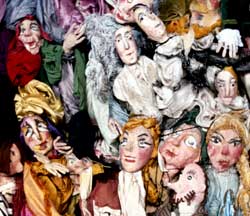
 Collezione
Maria Signorelli
Collezione
Maria Signorelli
Shadow puppets
The
Puppets of Maria Signorelli
The fairy tales, nursery rhymes and films
Shows with classical and modern texts, films
The ballets of Maria Signorelli
19th-20th century Italian rod and glove puppets
19th-20th century Italian marionettes
20th century foreign rod and string puppets
Sicilian, Pugliese and Neapolitan puppets
Shadow puppets
Toy
rod, glove and string puppets
Paper
and card theatres, sets and characters
Scripts
of puppet and marionette plays
Posters
of puppet theatre productions and festivals
This section comprises around one hundred items, from China, India, Malaysia, Thailand, Indonesia, Turkey and Greece.
The oldest shadow puppets go back to the early years of the twentieth century, and the most recent date from the 1950s on.
Shadow puppet theatre first appeared in China, where it has been documented since the Sung dynasty (960-1279): from there it spread to other Eastern countries. The Chinese shadow puppets are in perforated and coloured parchment, and range from 30 to 60cm in height; they have various points of articulation and a ‘rod of life’ fixed to the neck. The Indian silhouettes are very large, some even larger than lifesize: they vary in height from 120 to 180cm.
They are made of doe- or goatskin, made transparent and coloured, mainly in red: the thin cane supporting them is of datepalm.
The Thai shadow puppets are in slightly transparent skin, almost always red or grey, they are not articulated but seem rather like perforated pictures that the dancers hold over their heads, supporting them from below. Together with the rod, they are over a metre and a half high, and over 1.2m wide.
There are also smaller Thai silhouettes (around 60cm high), brightly painted, perforated and transparent.
The Malaysian silhouettes are in painted cow- or goatskin, but are not transparent. Some figures open and close the mouth and are around 50cm high. Among these, of particular note is the shadow of a figure with a club from Kelentan, of thick skin painted yellow and green, and a Wayang Kulit shadow from the same region, with a golden body with very thin limbs, with a baton of carved bone running through it up to the neck, and a brightly coloured perforated costume.
The most significant section is that of Javanese shadow puppets, which can be divided into Wayang Kulit (in skin) and Wyang Kelitit (in wood). The Wayang Kulit are cut out of a single piece of skin and supported by a baton made of wood or buffalo horn. The legs, as though atrophied, disappear into the costume, while the arms, disproportionately long, are articulated at the shoulder and at the elbow.
In this section a silhouette in the form of a triangular leaf (Gunungan) is of particular interest, painted on both sides with a tree of life that towards the base is gradually transformed into a temple with columns. With the rod it is around a metre high, and functioned as a little curtain at particular moments in the performance.
The Balinese shadow puppets are not slender like the Javanese ones, and could almost be contained in a rectangle. Two male figures with turban stand out through their expressive vivacity; they are around 40cm high, with a bone rod.
From Turkey, we have various examples of silhouettes of Karaghioz, the traditional character with a black eye (which is what the name means), who first appeared prior to the sixteenth century, a precursor of the Italian Pulcinella. The silhouettes are around 30cm high and their special feature is that the baton that moves them is fixed to any part of the body or the head.
Many of these shadow puppets were exhibited by Maria Signorelli in the exhibition Il
teatro delle ombre (The theatre of shadows), organized by her for the Commune of Carpi in 1983 (catalogue published as No. 5 of the
‘Quaderni del Centro di documentazione arti contemporanee’ of the Commune of Carpi).
 pictures
pictures